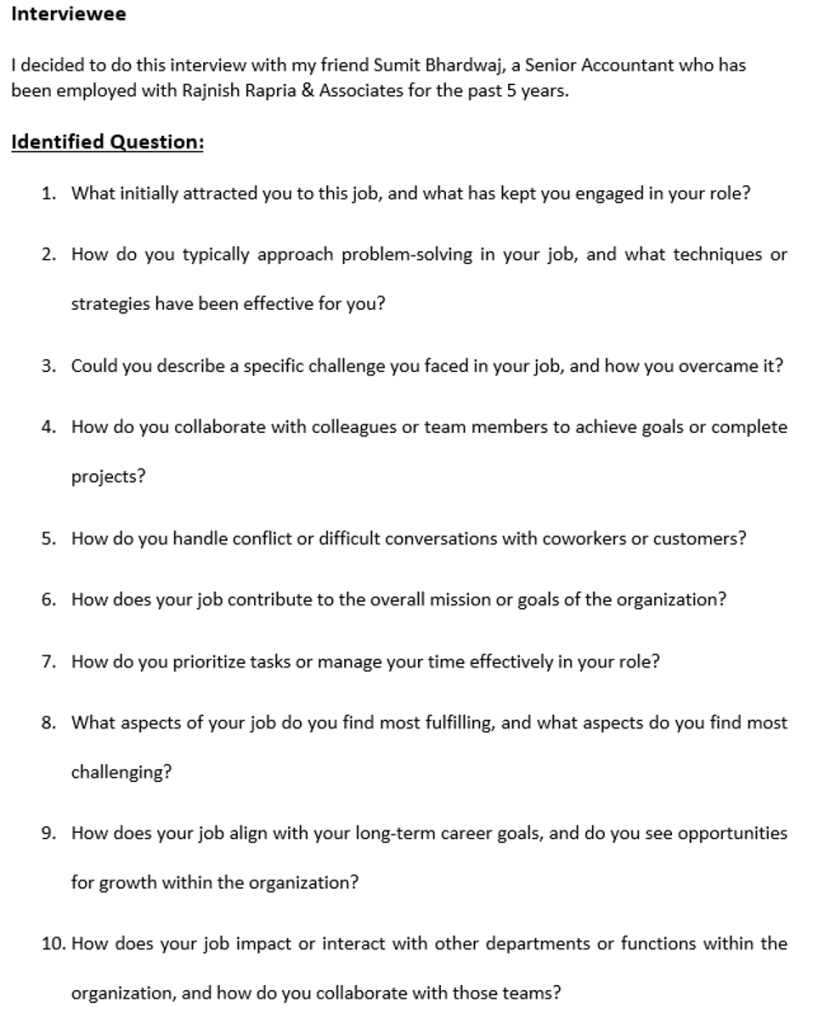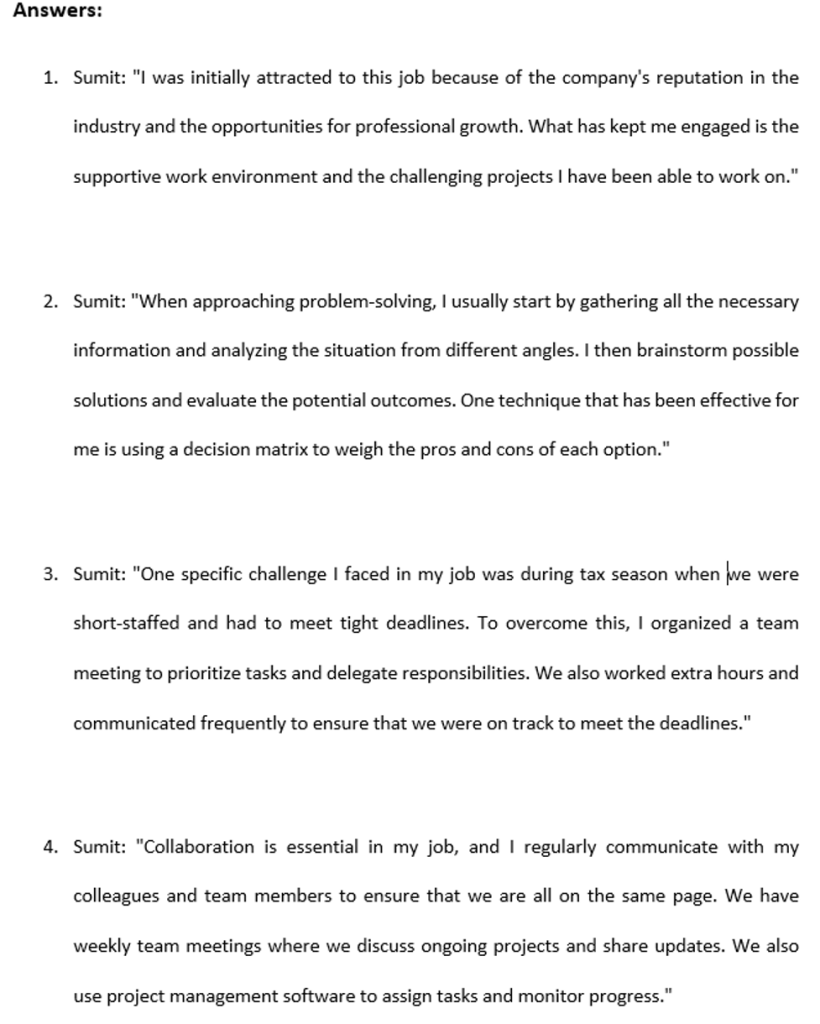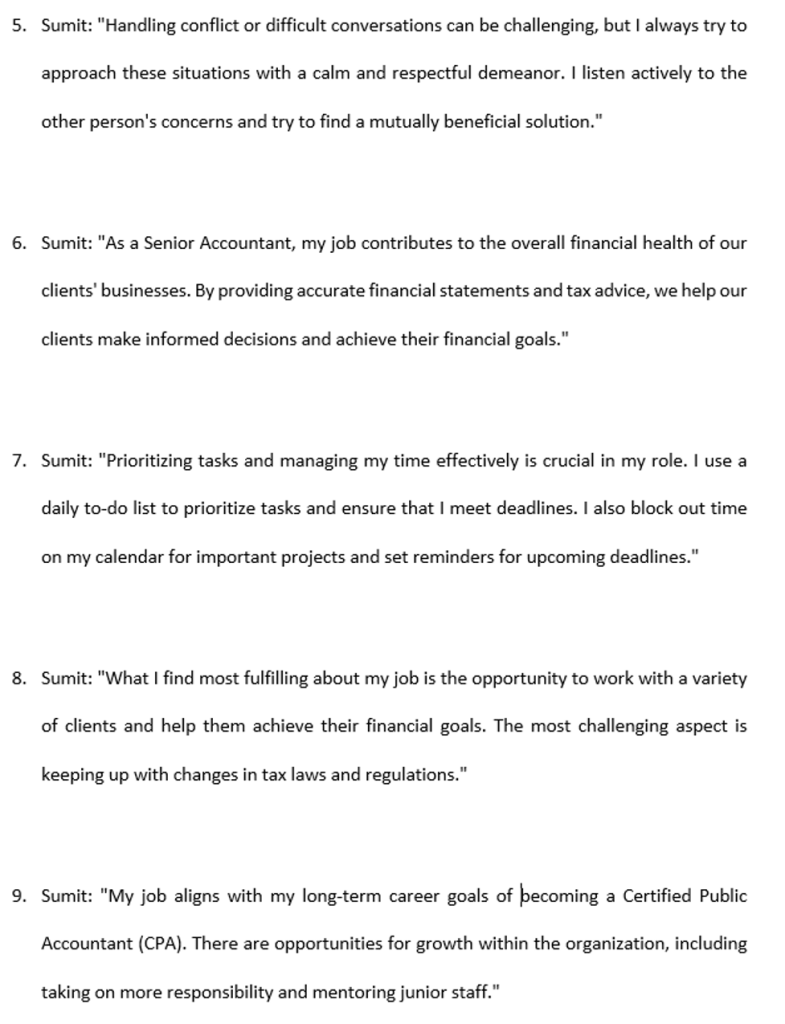Executive Summary
In this essay, a Senior Accountant called Sumit is interviewed about the strengths and problems of his workplace. Sumit works at Rajnish Rapria & Associates. This report discusses the various organizational behavior (OB) topics, including organizational culture, communication, collaboration, leadership, environmental factors, and change management, that were identified during the interview.
The analysis found several positive aspects, including a solid corporate culture encouraging cooperation and teamwork, efficient communication procedures, and capable leadership. The report did, however, also point out several areas that needed improvement, including the need to address workforce shortages, enhance the procedure for handling unforeseen changes, and better react to changing rules.
The report put forward several suggestions to deal with these problems. First, it suggested that the company create a structured onboarding procedure for new hires to strengthen the culture and teamwork of the business. Next, to prevent burnout and ensure the team is prepared for unforeseen developments, the business should prioritize maintaining adequate workforce levels. Third, the firm should conduct routine training and communication to ensure all employees know current rules and policies.
Interview Results
Organization Summary
Rajnish Rapria & Associates is a respected accounting company that offers clients financial services like tax guidance and financial statements. The company offers precise financial guidance and assists clients in achieving their financial objectives. The organization values collaboration and clear communication.
The interviewee, Sumit Bhardwaj, holds the position of Senior Accountant at Rajnish Rapria & Associates. He has worked for the company for the last five years, and his duties include advising clients about money matters and creating financial statements for them. He collaborates with coworkers and other team members to ensure tasks are finished on time and accurately.
Strengths Identified in the Interview
The company’s encouraging workplace culture is one of its advantages. In this setting, according to Sumit, he has been able to work on tough projects and further his career. This illustrates how a strong organizational culture can influence employee engagement and job satisfaction, two essential elements of employee retention and productivity. According to organizational behavior concepts, employees are likelier to stick with an organization when they feel appreciated, supported, and encouraged to further their careers.
The organization’s focus on teamwork is another one of its strengths. In the interview, Sumit emphasized the importance of teamwork and communication in accomplishing objectives and finishing projects. The performance of an organization can be improved by efficient teamwork and collaboration, as seen in this case. According to notions in organizational behavior about team dynamics, employees can produce creative ideas, improve problem-solving, and boost production when they collaborate and share their knowledge and abilities.
Problems Identified in the Interview
One of the issues the organization faces is how difficult it is to fulfill deadlines when the organization is understaffed during tax season. According to Sumit, he overcomes this obstacle by calling a team meeting, setting priorities, and assigning duties. Here is an illustration of how strong leadership and communication may enable groups to overcome obstacles and accomplish their objectives. Effective leadership includes setting clear expectations, expressing them, and assisting team members in achieving their goals.
Keeping up with evolving tax laws and regulations is another issue the business must deal with. According to Sumit, this is part of his job that presents the greatest difficulty. This illustrates how external factors and the significance of change adaptation and management can impact the performance of an organization. Environmental factors can significantly affect businesses. Any external elements that can impact a firm, such as those in the economic, social, technological, political, and legal spheres, are included in the environment. These elements may present opportunities or difficulties for firms, affecting their productivity, profitability, and long-term viability. To remain competitive and sustainable throughout time, it is crucial for businesses to monitor environmental factors and take appropriate action. Businesses can find opportunities, reduce risks, and boost performance by adjusting to the changing environment (Banda, 2020).
OB Concepts Linked to the Organization
Organizational Culture
A company’s organizational culture is essential because it affects how people behave, thinks, and value things (Langton et al., 2019). Sumit claims that the company’s supportive and collaborative atmosphere has kept him engaged in his job. Since Sumit frequently talks with his coworkers and team members to ensure everyone is on the same page, it appears that Rajnish Rapria & Associates’ culture values teamwork.
Organizational culture can be broken down into artifacts, values, and underlying presumptions (Belias & Koustelios, 2014). The outward manifestations of culture include artifacts like clothing codes, workplace design, and rituals. The weekly team meetings and project management software at Rajnish Rapria & Associates can be regarded as artifacts of the company’s culture.
On the other hand, values indicate what an organization considers important, such as collaboration, customer satisfaction, or innovation. The encouraging work atmosphere and chances for professional growth that Sumit highlights in the interview are consistent with the company’s values. These values, in turn, impact how employees behave, including how motivated and dedicated they are to the company.
The unsaid beliefs and perceptions that influence an organization’s culture are underlying assumptions. These presumptions are frequently embedded firmly and are challenging to alter, yet they can significantly affect organizational behavior. For instance, if Rajnish Rapria & Associates’ underlying presumption is that all employees should put in long hours during tax season, this may impact how employees behave and perceive what is expected of them.
Communication and Collaboration
Collaboration and communication are two key OB concepts that are interconnected and necessary for any business to succeed. Collaboration and effective communication can boost output, boost employee morale and job satisfaction, and encourage innovation and creativity (Langton et al., 2019).
In the interview, Sumit said that as a Senior Accountant, teamwork and communication are crucial aspects of his profession. He constantly interacts with his coworkers and team members to ensure everyone is on the same page. They review ongoing initiatives and offer updates at weekly team meetings. To allocate work and track advancement, they also employ project management software.
The information must be sent and received for communication to be effective and for a team to succeed. In this situation, Sumit and his team members are in contact with one another through various channels, including team meetings, emails, and project management software. This fosters respect and trust amongst team members, lessens the likelihood of miscommunications and conflicts and allows for open and honest communication between team members.
On the other hand, collaboration entails working together to achieve a single objective (Huxham & Vangen, 2013). In Sumit’s situation, he works with his coworkers and team members to complete tasks and meet organizational objectives. Clear communication, mutual respect, and trust among team members are necessary for effective collaboration. It also entails being aware of each team member’s advantages and disadvantages and using them to ensure everyone contributes to the group’s success.
Leadership
Another crucial OB idea that is illustrated in discussion with Sumit is leadership. As a Senior Accountant, Sumit must work closely with his coworkers and team members and guide and mentor junior staff. Achieving organizational objectives and fostering a healthy work environment depends on effective leadership. Transformational leadership is one type of leadership that applies to Sumit’s position. Transformative leaders energize and encourage people to realize their greatest potential and advance a common goal (Langton et al., 2019). Sumit expresses how much he appreciates the friendly workplace at his company, which may be due to management’s strong leadership.
Situational leadership is equally important for Sumit’s role. According to situational leadership, several leadership philosophies are suitable for certain circumstances. For instance, Sumit had to adopt a more directive leadership style to assign work and ensure deadlines were fulfilled during tax season when the team was understaffed. On the other hand, a more interactive leadership style may be more suitable during less stressful periods to promote teamwork and original problem-solving. Developing collaboration and teamwork, promoting a healthy work environment, and attaining organizational goals depends on effective leadership.
Environmental Factors and Change Management
Environmental factors are outside forces that affect how an organization operates. Examples include the state of the economy, technological breakthroughs, and alterations to the law and regulations. Contrarily, companies employ the change management process to plan, carry out, and track changes in response to internal or external influences. According to Sumit during the interview, one of the most difficult components of his job is keeping up with the changing tax laws and regulations. This highlights the significance of environmental elements and how they may affect an organization’s operations. In general, encouraging a positive work atmosphere, encouraging collaboration and teamwork, and attaining organizational goals depend on competent leadership.
Organizations must effectively manage change if they want to execute changes. When they were short on staff and faced a tight deadline, Sumit described how he called a team meeting to assign work and prioritize duties. This illustrates the significance of efficient change management when dealing with internal issues like workforce shortages.
Recommendations
Rajnish Rapria & Associates should invest in frequent training sessions and seminars to keep staff educated and current with any changes in laws or regulations that may affect their work. The training sessions could be led by internal staff members knowledgeable about the subject matter or by outside experts. The organization could also give them access to relevant information sources, including industry newsletters, official publications, and online resources to keep employees informed. Ensuring that everyone in the organization is informed of any changes that could affect their work also requires effective communication. The organization should set up efficient communication channels to quickly share information with all stakeholders. This can involve regular team gatherings, email updates, or a real-time intranet system. In addition to regular training and easy access to information sources, effective communication is crucial in fostering an environment that encourages learning and creativity in businesses. The organization may foster a culture of continuous learning and innovation and improve performance and outcomes by making regular training investments and establishing efficient communication channels.
The second suggestion is to ensure there is enough personnel to prevent burnout. Burnout is a condition of persistent stress or frustration-induced emotional, bodily, and mental tiredness that lowers productivity and job satisfaction. Increased absenteeism, turnover, and lower productivity are just a few of the detrimental effects of burnout on individuals and companies (Langton et al., 2019). Rajnish Rapria & Associates must ensure they have enough workers to handle the workload to combat burnout. This includes expanding the workforce, reorganizing the workload, or outsourcing particular duties. Employees will be better able to regulate their workload in this way, lessening stress and the possibility of burnout. The organization can improve work-life balance and lower employee burnout by ensuring adequate personnel. This will result in lower job expectations and more resources for employees. Giving workers tools to manage stress and balance their personal and professional life can also help achieve this objective.
Thirdly, Rajnish Rapria & Associates should enhance its orientation program. Any organization that wants to ensure that new hires can adapt to their new jobs and fit in with the current organizational culture must implement a proper onboarding procedure. With its strong culture and the value of teamwork in attaining the business’s objectives, Sumit’s organization sees this as especially vital. An orientation program that gives new workers an overview of the company’s history, culture, and principles could be the first step in a formal onboarding process. Mentorship opportunities, in which fresh hires are matched with seasoned workers who can help them navigate their early years in the company, might come after this. Ongoing feedback and support would also be essential to ensure that new employees feel valued and are provided with the resources they need. A rigorous onboarding procedure will enable Sumit’s company to better integrate new hires into the culture and help them reach their full potential. Also, it may lower turnover rates and raise employee satisfaction and productivity.
References
Banda, G. (2020). The Effects of Environmental Factors on the Performance of a Company. A Case Study of Patents and Company Registration Agency-(Pacra).
Belias, D., & Koustelios, A. (2014). Organizational culture and job satisfaction: A review. International review of management and marketing, 4(2), 132-149.
Huxham, C., & Vangen, S. (2013). Managing to collaborate: The theory and practice of collaborative advantage. Routledge.
Langton, N., Robbins, S. P., & Judge, T. (2019). Organizational behavior: concepts, controversies, applications (8th ed.). Pearson.
Appendix (INTERVIEW)




 write
write